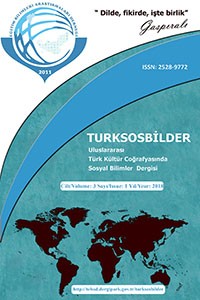SURİYELİ SIĞINMACILARIN GAZİANTEP'TE YAŞADIKALRI MEKANLARA İLİŞKİN GÖRÜŞLERİNİN İNCELENMESİ
Öz
The asylum seeker Syrians have tried both to adapt to changing
lifestyles of cities in which they have settled, mainly to border cities –
Gaziantep being among the first – starting from 2011, using their existing
culture and to conform their own life manner by making arrangements to adapt to
this new situation.
First of all, family’s not having a residence to live, found residence’s
being appropriate for social structure and satisfying the needs are important.
In this study, characteristics of residences where Syrians lived in Gaziantep
were evaluated. Several characteristics of residences and Syrians were
evaluated by questionnaire for having information about current situation of
residences, and to find out expectations. In order to compare residence characteristics,
185 Syrians in Gaziantep were interviewed in December, 2016. This study aims to
shed light on how Syrian will be able to apply data obtained from vital
locations within existing city order.
Anahtar Kelimeler
Kaynakça
- AFAD. (2017). 22 Mayıs 2017 İtibariyle Barınma Merkezlerindeki Suriyeli Sayısı: 248.660.Akan, Y., & Aslan, I. (2008). Göç Ekonomisi. Ekin Kitapevi Yayınları.Aksoy, Z. (2012). International Migration And Intercultural Communication. The Journal of International Social Research, 5(20), 293–293.Arslan, İ., Bozgeyik, Y., & Alancioğlu, E. (2016). Göçün Ekonomik Ve Toplumsal Yansımaları: Gaziantep’teki Suriyeli Göçmenler Örneği. İlahiyat Akademi Dergisi, 129–148.Etikan, I., Musa, S. A., & Alkassim, R. S. (2016). Comparison of convenience sampling and purposive sampling. American Journal of Theoretical and Applied Statistics, 5(1), 1–4.Gaziantep Govnership. (2017). Gaziantep Governorship Provincial Directorate of Immigration.Gürlesen, M. (2015). GAZİANTEP GAYRİMENKUL SEKTÖRÜ DEĞERLENDİRME VE ÖNGÖRÜLER 2020. Retrieved from http://www.gyoder.org.tr/uploads/Yayınlar/arastirma_raporlari/ar7.pdfİçişleri Bakanlığı Göç İdaresi Genel Müdürlüğü. (2017). 2016 Türkiye Göç Raporu. Retrieved from http://www.goc.gov.tr/files/files/2016_yiik_goc_raporu_haziran.pdfÖztürk, S., Örgen, N., & Çelebi, Ö. (2011). Gaziantep ilinin iç göç konusunda mevcut durum analizinin yapılması ve strateji belgesinin hazırlanması projesi (pp. 11–11).Özyılmaz, H. (2001). Investigation of user needs in new settlement areas in Diyarbakır in terms of housing and environment (Yayınlanmamış Yüksek lisans Tezi). Dicle Üniversitesi.Soylu, S. (2017). Bakan Soylu: Türkiye’de 3 milyon 551 bin 78 mülteci var. Milliyet.Tuzcu, P. (2008). Zorunlu Göç Ve Küresel Dönemde Değişen Nitelikleri: Türkiye Üzerine Bir İnceleme.Üner, S. (1974). Kırsal Yapıda Değişme ve Kırdan Kente Göçler. Hacettepe Sosyal ve Beşeri Bilimler Dergisi, Hacettepe University Publications, 6(1), 75–75.
AN INVESTIGATION OF SYRIAN ASYLUM-SEEKERS' OPINIONS ABOUT THE PLACES THEY LIVE IN GAZIANTEP
Öz
The asylum seeker Syrians have tried both to adapt to changing
lifestyles of cities in which they have settled, mainly to border cities –
Gaziantep being among the first – starting from 2011, using their existing
culture and to conform their own life manner by making arrangements to adapt to
this new situation.
First of all, family’s not having a residence to live, found residence’s
being appropriate for social structure and satisfying the needs are important.
In this study, characteristics of residences where Syrians lived in Gaziantep
were evaluated. Several characteristics of residences and Syrians were
evaluated by questionnaire for having information about current situation of
residences, and to find out expectations. In order to compare residence characteristics,
185 Syrians in Gaziantep were interviewed in December, 2016. This study aims to
shed light on how Syrian will be able to apply data obtained from vital
locations within existing city order.
Anahtar Kelimeler
Kaynakça
- AFAD. (2017). 22 Mayıs 2017 İtibariyle Barınma Merkezlerindeki Suriyeli Sayısı: 248.660.Akan, Y., & Aslan, I. (2008). Göç Ekonomisi. Ekin Kitapevi Yayınları.Aksoy, Z. (2012). International Migration And Intercultural Communication. The Journal of International Social Research, 5(20), 293–293.Arslan, İ., Bozgeyik, Y., & Alancioğlu, E. (2016). Göçün Ekonomik Ve Toplumsal Yansımaları: Gaziantep’teki Suriyeli Göçmenler Örneği. İlahiyat Akademi Dergisi, 129–148.Etikan, I., Musa, S. A., & Alkassim, R. S. (2016). Comparison of convenience sampling and purposive sampling. American Journal of Theoretical and Applied Statistics, 5(1), 1–4.Gaziantep Govnership. (2017). Gaziantep Governorship Provincial Directorate of Immigration.Gürlesen, M. (2015). GAZİANTEP GAYRİMENKUL SEKTÖRÜ DEĞERLENDİRME VE ÖNGÖRÜLER 2020. Retrieved from http://www.gyoder.org.tr/uploads/Yayınlar/arastirma_raporlari/ar7.pdfİçişleri Bakanlığı Göç İdaresi Genel Müdürlüğü. (2017). 2016 Türkiye Göç Raporu. Retrieved from http://www.goc.gov.tr/files/files/2016_yiik_goc_raporu_haziran.pdfÖztürk, S., Örgen, N., & Çelebi, Ö. (2011). Gaziantep ilinin iç göç konusunda mevcut durum analizinin yapılması ve strateji belgesinin hazırlanması projesi (pp. 11–11).Özyılmaz, H. (2001). Investigation of user needs in new settlement areas in Diyarbakır in terms of housing and environment (Yayınlanmamış Yüksek lisans Tezi). Dicle Üniversitesi.Soylu, S. (2017). Bakan Soylu: Türkiye’de 3 milyon 551 bin 78 mülteci var. Milliyet.Tuzcu, P. (2008). Zorunlu Göç Ve Küresel Dönemde Değişen Nitelikleri: Türkiye Üzerine Bir İnceleme.Üner, S. (1974). Kırsal Yapıda Değişme ve Kırdan Kente Göçler. Hacettepe Sosyal ve Beşeri Bilimler Dergisi, Hacettepe University Publications, 6(1), 75–75.
Ayrıntılar
| Birincil Dil | İngilizce |
|---|---|
| Bölüm | Makaleler |
| Yazarlar | |
| Yayımlanma Tarihi | 14 Haziran 2018 |
| Yayımlandığı Sayı | Yıl 2018 Cilt: 3 Sayı: 1 |


